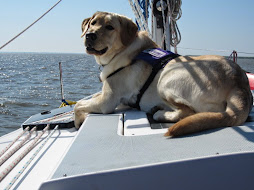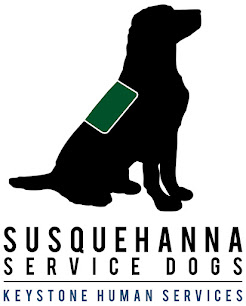While meals are being prepared, regardless of whether it's a four-course dinner or a quick midnight snack, our service dogs must stay away from the food. Dogs can either remain in a down-stay or just remain out of the area. We do not want our service dogs sniffing or counter-surfing (running their nose along the counters in hopes of swiping tasty people food). We actually do not even want service dogs to be underfoot when food is being prepared. The dogs could become a danger to both themselves and their partners if they're wandering through the kitchen while their partner is making a meal. Service dogs must also ignore any food left on counters, the stove, tabletops, etc. when their partner leaves the room.
We start teaching dogs to leave people food alone when they're still puppies. We start by crating them during food prep. Now, many people associate crates with punishment, but that isn't true for our service dogs. Crate actually become sources of comfort for the dogs, especially because service dogs are working dogs. When our dogs go in their crate, they know that work time is over and they can just relax and hang out.
If we don't crate puppies during food prep, we keep one eye on the puppy so we can proactively discourage any attempts to check out the people food. For example, we might use a gentle "eh-eh" sound or push them off the counter. When the puppy stays away from the counter on his own, we reinforce his behavior with good things, such as attention or treats.
To help teach puppies to ignore people food, some of our puppy raisers begin by eating a snack at a coffee table. They may use clicker training to reinforce the puppy's behavior when the puppy ignores the food. Using this method, one puppy raiser can now eat on the couch with her service-dog-in-training at her feet, and the dog shows no interest in the food!
When we find our older dogs (4-6 months or older) sniffing around the counters or with their paws actually up on the counter, we use stronger verbal correction and push the dog off the counter. For older dogs, a dog bed can serve as a good place to "anchor" the dog during food prep. The dog learns to stay on his bed while his partner is preparing food, unless instructed otherwise.
When teaching dogs not to counter-surf, it's important to remove any items from the counter that might tempt the dog, especially if you need to leave the room.
At meal time, our service dogs must lie quietly or just "hang out," meaning the dog stays away from the table and shows no interest in the food. This will take lots of practice. If dogs sniff at food, we use a verbal "eh-eh" sound. Some of our puppy raisers keep a cup of kibble on the table to reinforce their dog for good behavior.
Ultimately, our service dogs need to perform good manners around food regardless of where they go. This means that in restaurants, they must lie quietly under the table without sniffing, whining or barking. It's easiest to teach good behaviors at home and gradually introduce the dog to other environments to generalize behaviors.
Check out the photo on SSD Hawk's blog to see an example of a service-dog-in-training's self control around food. Even though some of the goodies are dog treats, it demonstrates the skills around food that we're looking for in our service dogs.
Look for our next post about dogs and bolting through doors.
Thursday, June 4, 2009
Subscribe to:
Post Comments (Atom)









No comments:
Post a Comment